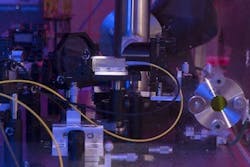30-tesla pulsed magnet has internal optical access for spectroscopy
Houston, TX--A tabletop magnetic-pulse generator developed at Rice University not only does better than conventional room-sized magnets; it also has direct optical access to its core which is the best location to carry on spectroscopic experiments.
The Rice Advanced Magnet with Broadband Optics (RAMBO) will allow researchers who visit the university to run laser-spectroscopy-based experiments on materials in pulsed magnetic fields of up to 30 tesla. In comparison, a high-resolution magnetic resonance imaging (MRI) system is about 10 tesla in strength. The Rice lab of physicist Junichiro Kono created RAMBO in collaboration with Hiroyuki Nojiri at the Institute for Materials Research at Tohoku University in Sendai, Japan. Details appeared online recently in the American Institute of Physics journal Review of Scientific Instruments.
The advantages of such a small machine are many, said Timothy Noe, a postdoctoral research associate in Kono’s group and lead author of the paper. Aside from its size and powerful performance, RAMBO has windows that allow researchers to directly send a laser beam to the sample and collect data at close range.
“We have direct optical access," says Kono, "whereas if you go to a national high-magnetic-field facility, you have a monster magnet, and you can only access the sample through a very long optical fiber. You cannot do any nonlinear or ultrafast optical spectroscopy. RAMBO finally gives us the ability to combine ultrastrong magnetic fields and very short and intense optical pulses. It’s a combination of two extreme conditions.”
Superfluorescence studies
The unit can run a new experiment in a 30-tesla field every 10 minutes (or less for smaller peak fields), as opposed to waiting the hours often required for field generators to cool down after each experiment at large laboratories. The device has already paid dividends for Kono’s group, which studies superfluorescence by hitting materials with femtosecond laser pulses to trigger quantum effects. RAMBO allows the laser pulse, the magnetic field pulse, and the spectrometer to work in sync.
RAMBO is possible, says Kono, because of Nojiri’s development of a small and light mini-coil magnet. A bit bigger than a spool of thread, the magnet allows Rice researchers to perform on campus many of the experiments they once carried out at the National High Magnetic Field Laboratory at Florida State University or at Los Alamos National Laboratory. The Florida State facility has produced continuous magnetic fields of 45 tesla; Los Alamos has produced pulses over 100 tesla.
“I would say we’ve been able to do 80 percent of the experiments here that we used to have to do elsewhere,” Kono says. “And that’s not all. There are things that only we can do here."
A sample plate sits on a long sapphire cylinder that passes through the coil’s container and juts through one end of the magnet to place it directly in the center of the magnetic field. The cylinder provides one direct window to the experiment; a port on the other side of the container looks directly down upon the sample. The coil is bathed in liquid nitrogen to keep it cool at around 80 K. The sample temperature can be independently controlled from about 10 K to room temperature by adjusting the flow of liquid helium to the sapphire cylinder.
Kono notes the team has already collaborated with Jean Léotin, a co-author of the paper and a professor at the Laboratoire National des Champs Magnétiques Intenses in Toulouse, France, to perform one of the first time-domain terahertz spectroscopy experiments in high magnetic fields.
About the Author
John Wallace
Senior Technical Editor (1998-2022)
John Wallace was with Laser Focus World for nearly 25 years, retiring in late June 2022. He obtained a bachelor's degree in mechanical engineering and physics at Rutgers University and a master's in optical engineering at the University of Rochester. Before becoming an editor, John worked as an engineer at RCA, Exxon, Eastman Kodak, and GCA Corporation.

